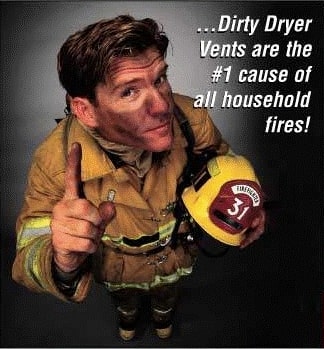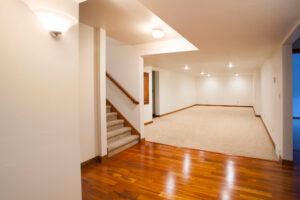Cleaning your lint trap after every dryer load is an important step to limit the danger of fire and extend the life of your clothes dryer
If your like most households with children you do countless loads of laundry each week. It is easy to take our washing machines and dryers for granted. These appliances are not seen as luxury, but rather a necessity for many.
However, many do not realize there is a hidden hazard lurking in the laundry areas of our homes and that is our clothes dryer. According to the Topical Fire Research Series, published by FEMA, “Clothes dryer fires account for about 15,600 structure fires, 15 deaths, and 400 injuries annually.” The bulletin goes on to add that “Failure to clean” is the leading factor contributing to clothes dryer fires in residential buildings” (source). So, with good reason, there are a number of precautions to take as well as routine inspection to ensure safe function of one of our hardest working household appliances.(photo above by americandryerventcleaning.com
So, what causes lint in a dryer vent duct system? The short answer to that question is when lint gets trapped, it blocks airflow. When airflow gets restricted, heat build-up and ultimately overheating can occur. This heat can ignite both the lint within the ductwork and can spread to the clothing within the dryer.
Beyond the fire hazard the average clothes dryer poses to our homes, most are operating well below their optimum efficiency. So, most of the same steps you can take to reduce the risk of disaster are the same things you can do to reduce drying time and increase the life of your clothes dryer. Keep reading to find tips on dryer venting, what problem areas to look for, and how to keep your dryer safe and clean. This information is brought to you by Gettum Associates Inc, Indianapolis area remodel contractors and home experts. You can get advice to your home improvement and household questions on our “E-mail the home expert” page.
Tips on dryer venting:
- It is best to use rigid metal duct work, rather than flexible duct work, especially for ducting that is concealed within walls and in the attic. The only acceptable use for flexible duct work is the small length between the rigid duct and the dryer (ex. from the wall to the dryer). Reason: Flexible duct work contains “ridges” that add friction that can grab and trap lint. If you must use flexible duct work, please choose metal flex duct over plastic duct work.
- Rigid duct work should be installed so that the connections between two pieces of duct work are oriented with the “male” end pointing towards the direction of airflow. Reason: If this connection is reversed, the crimped male end will collect lint and lead to build-up.
- Use “foil tape” NOT duct tape to seal duct joints. Duct tape will eventually dry out and fail. Also, DO NOT use screws or rivets to connect duct work. Screws or other fasteners will also collect lint.
- Keep the overall duct length less than 25′ as recommended by the IRC (International Residential Code). Here is what the IRC says about dryer duct vent length: M1502.6 Duct length:The maximum length of a clothes dryer exhaust duct shall not exceed 25 feet (7,620 mm) from the dryer location to the wall or roof termination. The maximum length of the duct shall be reduced 2.5 feet (762 mm) for each 45-degree (0.8 rad) bend, and 5 feet (1,524 mm) for each 90-degree (1.6 rad) bend. The maximum length of the exhaust duct does not include the transition duct.
- Check out the termination (end of the dryer duct and hopefully a termination cap). Your dryer SHOULD NOT vent into a crawlspace or an attic!! Again, we can reference the IRC for the proper termination of a dryer vent duct: M1502.2 Duct termination: Exhaust ducts shall terminate on the outside of the building or shall be in accordance with the dryer manufacturer’s installation instructions. Exhaust ducts shall terminate not less than 3 feet (914 mm) in any direction from openings into buildings. Exhaust duct terminations shall be equipped with a backdraft damper. Screens shall not be installed at the duct termination. Inspectors will see many dryer vents terminate in crawlspaces or attics where they deposit moisture, which can encourage the growth of mold, wood decay, or other material problems. Sometimes they will terminate just beneath attic ventilators. This is a defective installation. They must terminate at the exterior and away from a door or window! Also, screens may be present at the duct termination and can accumulate lint and should be noted as improper.
- The dryer vent duct should be independent from any other duct system (i.e. chimney, water heater, furnace, etc.) This should go without saying.
Tips on keeping your dryer vent and duct work clean:
- First, the easiest way to keep your dryer and duct work clean and working at optimal efficiency is to clean the lint trap screen each and every time. Also, be sure to check pant pockets coming out of the dryer for lint. Remove and discard.
- You should routinely inspect the connection from the back of the dryer to the wall. Make sure the duct work is not crushed and remember a gentle bend is acceptable but avoid sharp turns which can trap lint and ultimately block air flow.
- You should routinely disconnect, inspect and clean out the connection between the back of the dryer and the wall. This is the first place lint will collect and can be a major “choking” point of air flow.
- You should have your entire dryer vent duct system inspected and cleaned once per year for average laundry use. Consult the phone book or do an online search to find someone qualified and local to your area.
The information above is not intended to scare, rather it is to inform. Ultimately, this knowledge will keep you and your family safe and your clothes dryer working efficiently for years to come. If you should have any other questions relevant to home maintenance, remodeling and home improvement, please click here:





